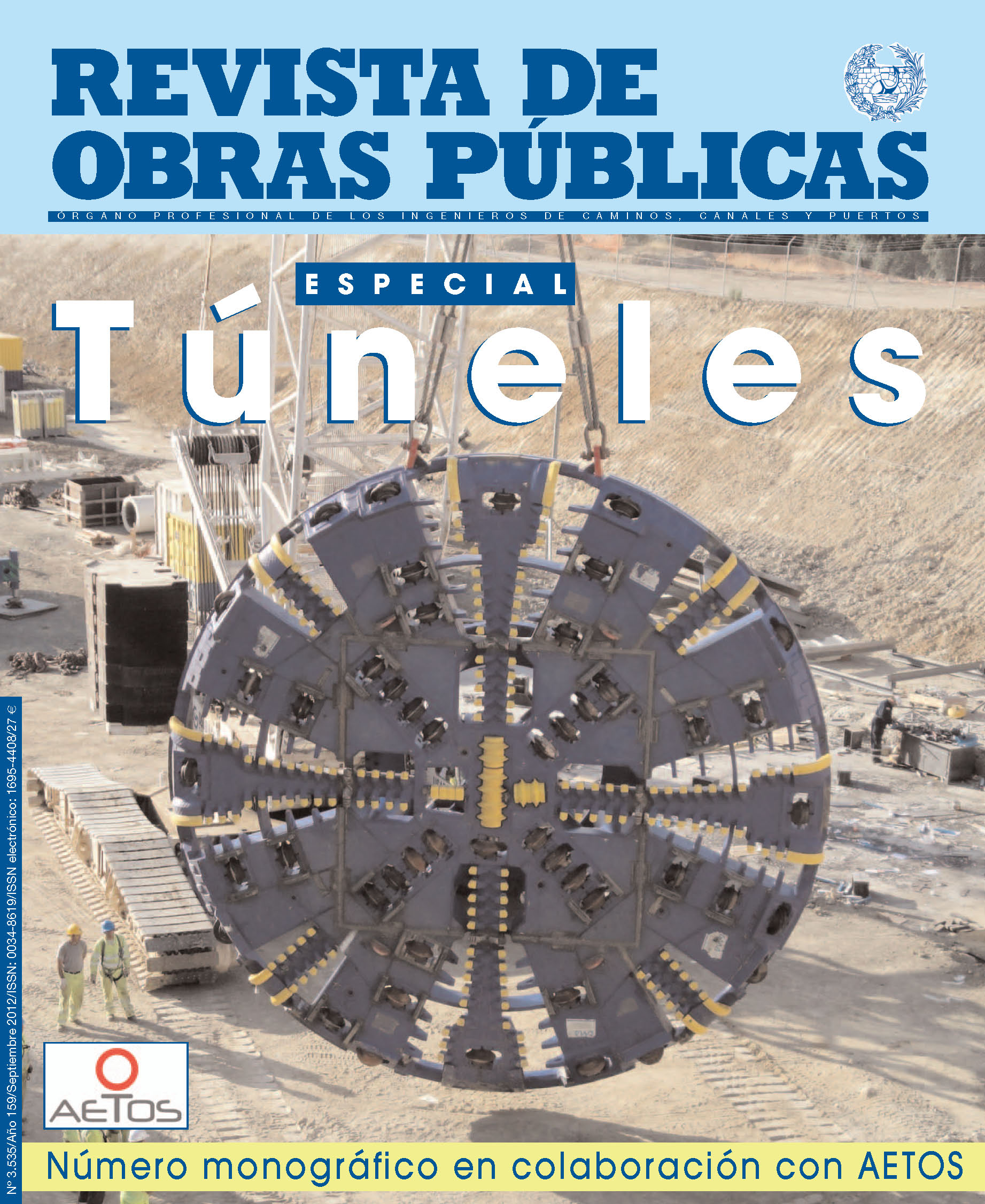
Portada del Número 3535 (Monográfico)

2012 / Número 3535: Especial Túneles (Monográfico)
Caracterización y comportamiento de un túnel en rocas doleríticas alteradas
Characterization and behaviour of a tunnel in weathered dolerite
Simic, Davor
Dr. Ingeniero de Caminos, Canales y Puertos Jefe de área de Geotecnia de Ferrovial Agromán. Profesor del Departamento de Ingeniería del Terreno. ETSICCP Madrid. Madrid (España). davor.simic@ferrovial.es
Fuente: 2012, 159, (3535): 41-62
Resumen en español
El túnel objeto de estudio es de doble tubo con una longitud media de 2991m y atraviesa la cara oeste de la cadena montañosa “Paliovigla – Paliokazarma – Kazarma” en Grecia, que forma parte del complejo montañoso de las Orthis El objeto fundamental del presente artículo es definir y acotar las distintas unidades geológicas que afectan al túnel a lo largo de su trazado, tanto desde el punto de vista geológico y geotécnico así como el análisis del comportamiento de los sostenimientos aplicados. Para ello se describen los criterios y metodología empleada a tal fin para luego mostrar los resultados obtenidos y sus implicaciones en el diseño, especialmente en los que atañe a los sostenimientos, del túnel. De acuerdo con lo anterior la estructura y orden de exposición es el siguiente: – Descripción del entorno geológico, debido a su singularidad y complejidad se presta especial interés en describir su dinámica y estructura a la vez que se caracteriza desde el punto de vista petrográfico, aspectos íntimamente relacionados. – Caracterización geomecánica de los materiales que afectan al túnel aplicando el método y clasificación Rock Mass Rating (RMR) desarrollado por Bieniawski en 1989 y el índice Q desarrollado por Barton en 1974. – Evaluación critica de los sostenimientos del túnel. Aquí se compararan los sostenimientos aplicados con los estimados a partir de los valores Q obtenidos en punto anterior. – Deformabilidad del macizo rocoso a partir de la clasificación geomecánica – Análisis de riesgo de fluencia – Estudio del comportamiento del macizo rocoso durante la excavación del túnel Como conclusión se refleja la idoneidad de los distintos sostenimientos para hacer frente a las deformaciones del macizo.
Palabras clave:
Túneles; Fluencia; Sostenimientos
Abstract
The subject of the study is a double-tube tunnel with an average length of 2991 m crossing the western slopes of the “Paliovigla-Paliokazarma-Kazarma” ridge of the Othrys massif in Greece. The main object of the article is to define and establish the different geological units affecting the tunnel throughout the route, from a geological and geotechnical point of view, and to analyze the behaviour of the supports applied. The article sets out by describing the criteria and methodology employed to this effect and then goes on to indicate the results obtained and their design implications and particularly in respect to the tunnel supports. With this in mind, the article will subsequently be laid out and arranged as follows: – Description of the geological environment. On account of the complexity and singularity of this environment, particular reference is made to the dynamics and structure of this environment and the interrelated aspects of the same from a petrographic point of view. – Geomechanical characterization of the materials affecting the tunnel using the Rock Mass Rating (RMR) method developed by Bieniawski in 1989 and the Barton “Q” Index developed in 1974. – Critical evaluation of the tunnel supports. The applied supports are compared with those estimated on the basis of the “Q” values obtained earlier. – Rock mass deformation according to geomechanical classification. – Creep risk analysis – Study of the behaviour of the rock mass during the excavation of the tunnel. By way of conclusion, reference is made to the suitability of the different supports to offset rock deformation.
Key words:
Tunnels; Creep; Supports
Referencias bibliográficas
–[1] BARTON, N. LIEN, R. and LUNDE, J. (1974). “Engineering classification of rock masses for the design of tunnel support”. Rock mechanics, Springer Verlag, col. 6, pp 189-236
–[2] BIENIAWSKI, Z. T (1989). “Engineering rock mass classifications”. John Wiley and Sons, Inc.
–[3] FOUCAULT, A. and RAOULT, J.F. (1980). Dictionnaire de Géologie, Ed. Masson.
–[4] GRIMSTAD, E., and N. BARTON (1993). “Updating the Q-system for NMT. Proceedings of the International Symposium on Sprayed Concrete: Modern
Use of Wet Mix Sprayed Concrete for Underground Support”. Oslo: Norwegian Concrete Assn.
–[5] E.HOEK y P. MARINOS (2000). “Predicting tunnel
squeezing problems in weak heterogeneous rock masses (2000)”. Tunnels and Tunnelling November and December issues, pp 45-51 and pp 33-36
–[6] E.HOEK, P. MARINOS y V. MARINOS (2006). “Variability of the engineering properties of rock masses quantified by the Geological Strength Index:
the case of ophiolites with special emphasis on tunneling”. Bulletin of Engineering Geology and the Environment. Vol. 65. pp 129-142
–[7] M.CAI, P.K. KAISER, Y. TASAKA y M. MINANI(2006). “Determination of residual strength parameters of jointed rock masses using the GSI system”.
International Journal of Rock Mechanics and Mining Sciences. Volume 44, Issue 2, pp 247-265
–[8] OMIKROM KAPPA CONSULTING (2009).“TU.026 (T2) - Final design of tunnel mined part excavation and initial support. Technical report”.
–[9] SERAFIM, J.L. and PEREIRA, J.P. (1983). Considerations of the geomechanics classification of Bieniawski. Proc. Int. Symp. Eng. Geology. Lisbon.
2 artículos publicados en esta revista por: Simic, Davor
Caracterización y comportamiento de un túnel en rocas doleríticas alteradas
2012, 159, (3535): 41-62
Settlement control: assuming the challenge of underground construction in London El control de asientos: asumiendo el reto de la construcción subterránea en Londres
2015, 162 (3568): 97-106
Realización del Colegio de Ingenieros de Caminos, Canales y Puertos con la participación del CINDOC.
Con la colaboración del CEDEX-CEHOPU y la Escuela Técnica Superior de Ingenieros de Caminos, Canales y Puertos de Madrid
© Copyright: Colegio de Ingenieros de Caminos, Canales y Puertos (España)
Propiedad del Colegio de Ingenieros de Caminos, Canales y Puertos (España). Prohibida toda reproducción total o parcial sin citar la fuente.
Property of the Colegio de Ingenieros de Caminos, Canales y Puertos (Spanish Society of spanish engineers). Reproduction by whatever means of the whole or any part of the content is strictly forbidden without reference to source



